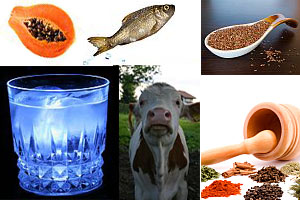Drink Your Vegetables! Guide to the Best Vegetable Juice Options
Experts recommend that we get 9 servings of fruit and vegetables each day in order to stay healthy and reduce our likelihood of a wide range of diseases, including heart disease, diabetes, stroke and cancer. An evaluation of long-term studies conducted in Europe and the US found that those who ate more than 5 servings of fruit and vegetables daily had a 20 percent lower risk of stroke and coronary heart disease than those who ate fewer than 3 servings per day.
Although fruit is very healthy (it provides lots of vitamins and fiber), it contains a lot of sugar in the form of fructose. This is why experts say that about three-fifths of those 9 servings of fruit and vegetables should be comprised of vegetables. But it’s not easy for a lot of people to get those all-important servings each day, given our increasingly busy schedules. Luckily, it’s relatively simple to get your daily veggies from drinking juice.
Just to be crystal clear on this point—it is generally better for you to eat whole vegetables either raw or very lightly cooked as often as possible. Vegetable juices are generally pretty low in fiber, depending on the juice (or juicer) you get. Fiber is important for digestive health, reducing the risk of constipation and keeping your cholesterol at a healthy level. Nevertheless, drinking vegetable juice is far better than getting little or no vegetables at all!
Juicing can be a particularly useful option for people who have digestive issues. To get the most nutritional value from your vegetables (or from any other food you eat, for that matter), your body must first break them down during digestion. Generally speaking, the simple act of chewing and swallowing our food so that it can be dissolved elsewhere along the digestive tract should be sufficient to release the nutrients in whatever we eat. However, some people (including the elderly, whose digestive enzymes may not be as powerful as they once were) have digestive problems that interfere with the absorption of nutrients. Since juice has had most of the vegetables’ cellulose removed or broken down, it’s easier for the digestive system to absorb all those important nutrients.
For veggie juices with the highest nutritional content, consider juices featuring some of the following vegetables:
- Tomatoes – Possibly the best vegetable to juice, tomatoes contain lycopene, which has been shown to lower the risk of prostate cancer and is supportive of heart health.
- Kale – Chock full of vitamins and minerals, including vitamins B, C and K, calcium, copper and magnesium, kale also is high in cancer-fighting phytonutrients.
- Cabbage – Helps protect against ulcers, and its indoles help to regulate metabolism and the balance of estrogen.
- Peppers – Red bell peppers in particular are high in vitamin C and antioxidants. Adds a refreshing flavor to any vegetable juice.
- Celery – High in potassium, celery helps to regulate blood pressure. It also reduces uric acid in the blood, which is good news for anyone with gout.
- Spinach – High in the cancer-fighting antioxidant lutein, spinach is also high in vitamins A, C and E, and is a good source of calcium, folic acid, iron and potassium.
- Carrots – These contain large amounts of beta carotene, good for the skin, eyes, brain and arteries. They blend well with other vegetables as well. Just be sure to use them somewhat sparingly, as they are also quite high in sugar.
- Parsley – Cleanses the liver and kidneys and is supportive of heart health. It is also high in vitamin C.
So drink up, and enjoy the health benefits you can gain from these wonderful vegetables!
- Special Note: Using a high-powered blender such as a Blendtec or Vitamix Blender allows you to get your juice and fiber as well! Not everyone can afford one but for those that can, it can be a wonderful investment!



 Chiropractic Can Help Asthma, COPD and More…
Chiropractic Can Help Asthma, COPD and More… Have you ever tried to blow up a balloon while someone was sitting on it? Obviously, this would not be an easy task. If you sit down and lean over, stretching your hands toward the floor in front of your feet, your breathing is far more difficult, because the two balloons in your chest—your lungs—cannot be filled as easily with air.
Have you ever tried to blow up a balloon while someone was sitting on it? Obviously, this would not be an easy task. If you sit down and lean over, stretching your hands toward the floor in front of your feet, your breathing is far more difficult, because the two balloons in your chest—your lungs—cannot be filled as easily with air.
 The National Highway Traffic Safety Administrations reports that more than two million people are injured every year in auto-related accidents involving either a passenger vehicle, large truck, or motorcycle. Furthermore, that number appears to be climbing at an alarming rate, increasing more than five percent between 2014 and 2015 alone.
The National Highway Traffic Safety Administrations reports that more than two million people are injured every year in auto-related accidents involving either a passenger vehicle, large truck, or motorcycle. Furthermore, that number appears to be climbing at an alarming rate, increasing more than five percent between 2014 and 2015 alone.

 10 Health Benefits of Onions
10 Health Benefits of Onions